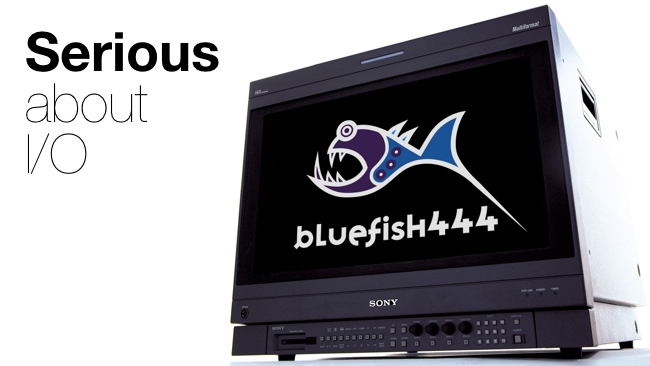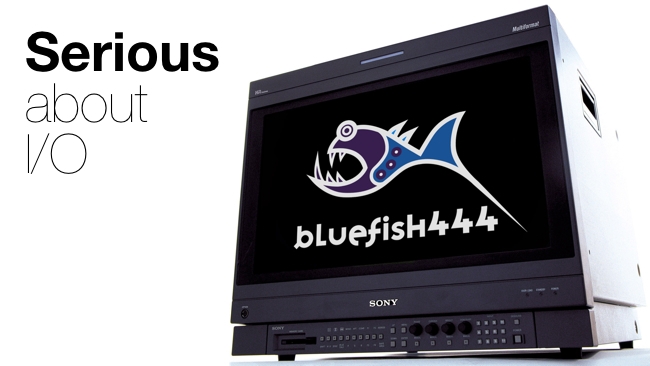
 Serious about I/O
Serious about I/O
RedShark has been speaking to the Australian I/O specialists Bluefish444. We asked them about their current products and how they see the future shaping up
How did the company get started?
Bluefish444 started out supplying uncompressed SD SDI/Analog Input and Output solutions for workflows involving the Adobe Creative Suite range of products. At the same time we developed a multi channel I/O SDK and many 3rd party manufacturers from our industry began to adopt our video cards for I/O inside their own products. We next played a leading role in the pioneering years of 444 Digital Intermediate workflows, developing a 444 RGB/422 YUV I/O video application for our first High Definition video cards called Symmetry. Symmetry was a way into the world of DI world for many customers giving them a sophisticated yet user friendly tool to ingest and master DPX files using RS422 machine control.
What was the typical kind of video set-up you were catering for at the beginning?
Some of the earliest Bluefish444 cards were leading the way with Analogue SD Video and Audio Capture and included real proprietary software and CODECS.
How has your approach changed since then in terms of a) Technology and b) the shape of the market?
The industry in general is much more mature. People have been working Non-Linear for a long while now and so workflows and technology have found a happy medium. For the most part! With some of our earliest gear the industry did not have a whole lot of choice about how things had to be done. For example if we supported a CODEC then the workflow would find a way to accommodate it. Nowadays the industry expects a certain level of support from every technology partner, and if it does not support a CODEC required it will not fit into the workflow. The CODEC is just and example, it can apply to colour space, or pixel formats, or even resolution support.
What is it that makes people come to you as opposed to other companies in this field?
Bluefish444 have a reputation for being “The Professionals Choice” which has evolved over time after consistent feedback from industry professionals and OEM (Original Equipment Manufacturers) alike. Our customers come to us because the products the we create do exactly what we say they do. Most of our new customer are won when they have experienced issues with a provider and cannot afford to continue with products that are not reliable.
What is your response to the trend towards file-based workflows?
The transition to file based workflows has seen many ups and downs, as I am sure anyone who has lost material from a shoot will tell you. Ultimately that transition was necessary for the industry to produce cost effective content at the rate that was required. One thing that has not changed with the adoption of file based workflows is the absolute requirement for professional video and audio monitoring during all stages of Production and Post Production.
Do you see 3D/Stereoscopic as being important in the future?
While Stereoscopic is not currently a hot topic i suspect that it is not going to stop being an important part of entertainment today, or into the future.
What do you think about 4K and what's your response to it?
4K has generated a huge amount of interest recently, both in the media and in the film and broadcast industry. While many are divided about the rapid adoption of this format most would agree that the pictures when viewed on professional displays or projectors are astounding and therefore it will ultimately be good for the industry. What is really going to be interesting is the way that the consumer can access this content, given that 4K files will be large downloading or streaming may not be feasible yet, likewise traditional over the air or satellite broadcasts face technical hurdles while also competing with content delivered through IP. Finally we could see a move back to physical mediums, like Blu-Ray, to transport and store content which currently may just be too big to download, stream and store on your computer.
Right now Bluefish444 are completing 2nd and 3rd generation drivers supporting 4K video through our “Epoch 4K Supernova” so it is actually not so new to us now. Content creation tools like Adobe CC and Assimilate SCRATCH have a flexible enough plug-in architecture that we have been able to bring things like 4K 60P to Adobe Premiere, and we can be the only ones to bring full 10-bit RGB 4K support to Assimilate SCRATCH. OEM customers are also finding the transition to 4K not so hard: with the SDK we provide samples to allow 4K video capture and output.
Do you get involved at all in metadata like LUTs?
Bluefish444 hardware has 4 x 1D programmable LUTs, and each frame is processed at 12-bit precision. Colour space conversions are done with enough precision as to avoid rounding errors and produce stunning and accurate images. We also have full support for Ancillary data that is included in the HD-SDI standards, including custom packets like the ARRI record flag and others.
What shape do you think the industry will be in in 5 year's time (ie what are the trends today and where are they headed?)?
As mentioned earlier on we think that the industry is right on the edge of a major transition in delivery mechanisms of its content, this could possibly be helped along by the introduction of 4K content into the home. I would suggest that in five years time we will all be able to access some form of higher than HD content in the home. A simultaneous transition to High frame rates may cause some delay in the immediate adoption but I suspect that both will be adopted. With that in mind the technology around Stereoscopic viewing will also have moved along hopefully with the realisation of acceptable 3D without the need for glasses.
Tags: Technology


Comments